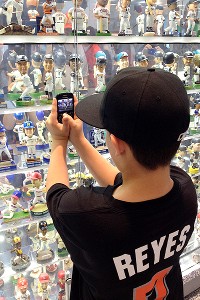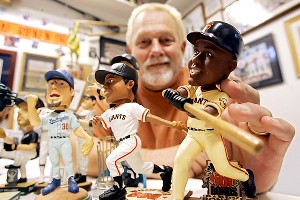Aug 31 2012 09:34 AM
Re: Going Back To Miami or Mets Gone Fishin?
Marlins create own bobblehead museum
By Doug Williams | ESPN.com
Marlins owner Jeffrey Loria has personally amassed much of the team's
bobblehead display.
| his past winter was a busy one for the Miami Marlins, who invested in shortstop Jose Reyes, closer Heath Bell and starting pitcher Mark Buehrle for their first season in Marlins Park. In separate moves hardly noticed outside South Florida, the team also acquired Carlos Beltran, Fernando Valenzuela, Willie Mays and Robin Yount. The four -- and hundreds of others -- are part of a collection of more than 1,000 bobbleheads compiled by Marlins owner Jeffrey Loria to display in his shiny new ballpark. Marlins Park not only features that Giant Garish Thing In The Outfield that shoots off fireworks after a hometown homer, tropical aquariums and a retractable roof, but also the Bobblehead Museum on its main promenade behind home plate near the team store. Or, as it’s also labeled, the “Museo de Bobblehead.” It’s a glassed-in, two-sided display case for 609 bobbleheads (the most that can be displayed at one time), with one side for the AL and the other for the NL. The case has interior lighting so every little player is clearly visible, and each shelf has its own vibrating mechanism so the heads on the little dolls are constantly in motion. While the Marlins’ first season in their new park has been largely disappointing, the museum -- the largest permanent and public display of bobbleheads in the big leagues -- has been a hit. “It’s tremendous,” said Chelsea Hirschhorn, the team’s associate counsel and director of special events who oversees the collection, when asked about fan interest. “Absolutely tremendous. Honestly, it’s a place not only for Marlins fans, but our out-of-town-team fans to really connect to our ballpark. It’s a breath of history and moments in time that people can relate to. “A lot of bobbleheads reflect special moments. ... It’s like any commemorative museum in that respect. You see fathers pointing out to their children moments that they themselves watched on TV. It’s very cool.” She called it a “360-degree experience” in which fans circle the display and stop to examine favorites. Loria acquired the bobbleheads from a variety of sources, but the majority came from Houston Astros visiting clubhouse man Steve Perry, who sold Loria more than 600 from his collection for an unspecified price. He’d kept the little dolls in his office at Minute Maid Park since he started collecting in 2001.  The Marlins' bobblehead case holds 609 of the team's collection, which now numbers more than 1,000. Loria thought adding a bobblehead museum at his new park would be a fan-friendly feature. And, though there are more than 1,000 pieces in the collection, he told MLB.com earlier this year, “We’re going to keep building the collection.” “It’s not for kids,” he said when the new ballpark opened in April. “It’s for kids like me. It’s something different that you don’t see.” Loria, a successful art dealer, views the bobbleheads from a collector’s perspective. “They’re fabulous little objects,” he told the Palm Beach Post in June. “They’re sculptures. To me, they’re works of art.” There certainly are bobbleheads with a Marlins flavor. There’s Craig Counsell raising his arms in triumph in the Florida Marlins’ Game 7 victory of the 1997 World Series, former standout hitter Jeff Conine and even current manager Ozzie Guillen as a shortstop from his days with the Triple-A Las Vegas Stars. But there also are mascots from around the major leagues, baseball announcers and stars past and present. Hirschhorn’s favorite is “The Catch” bobblehead of Willie Mays that recreates his celebrated back-to-the-diamond running grab in the 1954 World Series. It was given to fans by the San Francisco Giants in May 2010. “Not only does his head bobble, but he’s actually reaching out to make that famous catch and the baseball itself is on a spring, so it bobbles as well,” she said. As of now, the Bobblehead Museum display is “at capacity,” said Hirschhorn, with a few open slots to accommodate new figures that will be given away this season by other teams. With some bobbleheads in storage and more being made each year, she said the team could eventually add another kiosk to the museum. Certainly, there are other bobblehead collections to be mined. Across the country, for instance, Harvey Hodgerney has more than 700 bobbleheads covering his desk and the shelves in his office at AT&T Park in San Francisco. Hodgerney, the visiting clubhouse attendant for the Giants since 1984, has been collecting since 1999, when the team ignited the current bobblehead boom by giving away figures of Mays, Willie McCovey and Barry Bonds.  Harvey Hodgerney, visiting clubhouse manager for the San Francisco Giants, turned down a $50,000 offer to sell his collection to the Marlins. “I thought it was neat,” said Hodgerney of his first three. “It just started growing and growing and growing.” His collection isn’t out in the open the way the Marlins’ is, but fans who take tours of AT&T Park are often welcomed in personally by Hodgerney to see his bobbleheads or can look through his office window when he’s unavailable. Hodgerney said Loria approached him last season about buying the collection to display in Miami. “He came in and he says to me, ‘Do you know what it’s worth?’ And I said, ‘No, I don’t,’" said Hodgerney. “So he came in the next day and he goes, ‘You figure it out?’ And I go, ‘No.’ He says, “I’ll give you $50,000. And I said, ‘Let me think about it,’ and I told him no. Because, you see, all the bobbleheads I’ve got, if a guy’s been through here, they’ve signed them for me.” He said some players have noticed gaps in his collection and filled them. “Larry Walker one time came in and said, ‘Wait a minute, I don’t see mine.’ He said, ‘I’ll make sure you get it,’ and he brought it to me,” said Hodgerney. Hodgerney also has sought out bobbleheads from the early 1960s, when generic bobbleheads in team uniforms were sold. But his favorite, he said, is a little bobblehead trophy given to him by a boy of about 9 who brought it in for him because he noticed Hodgerney didn’t have one like it. That one’s special. While the Marlins’ total might now be larger than his, Hodgerney said people in baseball have told him he has the largest personal collection of bobbleheads. “Nobody’s heard of anybody else having that many,” he said. That doesn’t mean, however, that he won’t someday part with it. What if Loria, for instance, were to make another offer? “If he came up with the right amount of money, I would [sell],” said Hodgerney. |
http://espn.go.com/blog/playbook/fandom ... collection














